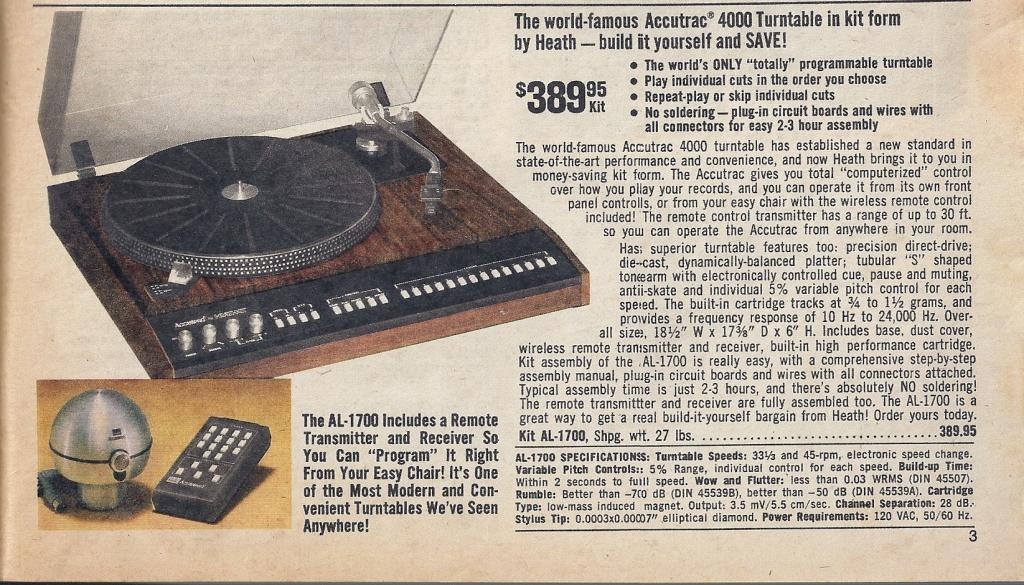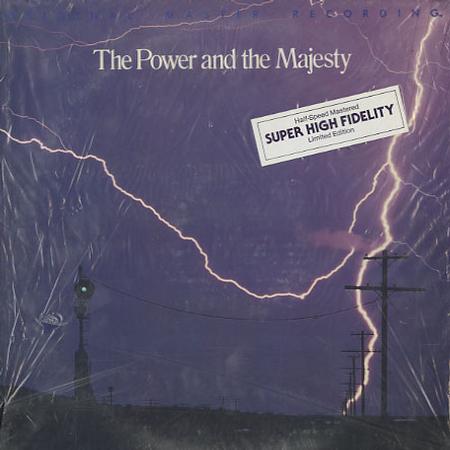Stereo, the early days.
[Deleted User]
Posts: 7,658
Hello,
Here's what the early days of stereophonic recording was like:
http://www.soundfountain.com/cook/cook-livingston-binaural.html
Enjoy, Ken
Here's what the early days of stereophonic recording was like:
http://www.soundfountain.com/cook/cook-livingston-binaural.html
Enjoy, Ken
Comments
-
I have always wondered how they get 2-channel out of a single stylus.Source: Bluesound Node 2i - Preamp/DAC: Benchmark DAC2 DX - Amp: Parasound Halo A21 - Speakers: MartinLogan Motion 60XTi - Shop Rig: Yamaha A-S501 Integrated - Source: Rotel CD14MkII CD Player - Speakers: Elac Debut 2.0 B5.2
-
Pretty cool, thanks KenSDA SRS 2.3TL's
Silk Audio MS-90-BT integrated tube amp
Yaqin MS-20L integrated tube amp
SDA 2B TL's -
WOW there are some freaky tonearms there:)
-
KennethSwauger wrote: »Hello,
Here's what the early days of stereophonic recording was like:
http://www.soundfountain.com/cook/cook-livingston-binaural.html
Enjoy, Ken
I had a feeling that was going to be the topic of this thread ;-PI have always wondered how they get 2-channel out of a single stylus.
It's actually pretty clever, and perhaps non-obvious (except in retrospect);
http://www.vinylrecorder.com/stereo.html
image source: http://ortofon.com/hifi/products/cartridges/2m-series/2m-mono-se
As an old-guy, Luddite aside -- I am (still) amazed and inspired by the tremendously clever, insightful, and challenging way that analog electronic engineering delivered good-performing (even, arguably, high-performing), compatible solutions to:
* Mono compatible stereo records
* Mono compatible stereo FM
* B&W compatible color television
Way more challenging, both in terms of concept, design and execution, than today's brute force, write a few million lines of code and then go to Starbucks modus operandi :-P
Some bright, clever, and dedicated/motivated folks.
-
I like one arm on top and a second one underneath, talk about alignment headaches!
-
It would seem that taping would not have any of these limitations as you can record though dual, or quad heads (or more) on the same tape. So the question is, and I really haven't thought about it till now, even though I kind of remember monophonic LPs and sound, when did RTR units first record STEREO sound?Currently orbiting Bowie's Blackstar.!
Polk Lsi-7s, Def Tech 8" sub, HK 3490, HK HD 990 (CDP/DAC), AKG Q701s
[sig. changed on a monthly basis as I rotate in and out of my stash] -
pretty much thought that with all those in the article...KennethSwauger wrote: »I like one arm on top and a second one underneath, talk about alignment headaches!
-
It would seem that taping would not have any of these limitations as you can record though dual, or quad heads (or more) on the same tape. So the question is, and I really haven't thought about it till now, even though I kind of remember monophonic LPs and sound, when did RTR units first record STEREO sound?
Yes, discrete multi (2, 3, 4... n) channel is most easily achieved with tape. Even in the case of tape, there have been multiple formats for, e.g., consumer stereo.
The big problem with tape, I'd opine -- is it's not "random access". Records are, whether by manual intervention or some of the fanciful "random access" record players available over the years. Acutrac by Mark Hardy, on Flickr
Acutrac by Mark Hardy, on Flickr
The Heathkit morph of the (in)famous ADC Accutrac 4000 :-P
Looks like consumer "stereo" ("binaural") tape dates back to at least 1955...
source: www.alliedcatalogs.com (1955)
The first commercial quad consumer "hi fi" format, it may be recalled, was eight-track tape :-P scan0002 by Mark Hardy, on FlickrKennethSwauger wrote: »I like one arm on top and a second one underneath, talk about alignment headaches!
scan0002 by Mark Hardy, on FlickrKennethSwauger wrote: »I like one arm on top and a second one underneath, talk about alignment headaches!
Puts me to mind of vintage juke boxes ;- )
-
Emory Cook is credited with offering the first commercial stereo tape in March of 1953, a recording of Brahms First Symphony.
Previously he had been known for field recordings of locomotives and steel drum playing. Seems like all these guys started recording steam engines. -
...something Freudian about that (the steam locomotive thing, I mean).
Mobile Fidelity/Mobile Fidelity Sound Labs also got its start recording steam locomotives and thunderstorms.
http://www.mofi.com/Articles.asp?ID=255
Ken, you should put up an iron oxide website! :- )
-
Probably the most famous of the train recordists:
http://www.npr.org/templates/story/story.php?storyId=4585996
I remember reading a story (on an album jacket I think) where he had set up his tape recorder beside a crossing in anticipation of getting a combination of the train approaching, the signal bell and then the train roaring past. In those days he didn't have a portable tape recorder but had bought an hour's worth of electricity from a nearby house. A few minutes from the all important event the lady of the house pulled the deck's plug and told him, "your time is up!". He quickly bought another hour's worth of juice and made the recording, which is amazing listening. -
heh. iron horse, iron oxide, and steam.
"Oxford comma" and all :- )
-
Awesome post.
I like the part about the Long Island Sound.
A lot of AV history here on L.I.B&W CM9Classé Sigma -
I actually bought this one back in the day.mhardy6647 wrote: »...something Freudian about that (the steam locomotive thing, I mean).
Mobile Fidelity/Mobile Fidelity Sound Labs also got its start recording steam locomotives and thunderstorms.
http://www.mofi.com/Articles.asp?ID=255
Ken, you should put up an iron oxide website! :- )
-
I didn't -- not enough discretionary income (times was tough in the 1970s, man...) ;- )
If I had it all to over again, I'd have bought two of all of the early ones & kept a sealed one of each.
Yeah... -
Another really worthwhile company was based in Bayside, Long Island namely Everest Records and tapes. In fact their two track tapes are among the best audio quality I've heard. The company was founded by industrialist Harry Belock, who had produced electronics for early missiles and the main audio engineer was Bert Whyte. Mr. Whyte was a mainstay in High Fidelity and Audio magazines. Belock was an avid audiophile and knew he could make a better sounding recording than anyone else. He pioneered the use of 35mm magnetic tape for recording which was later sold to Mercury.
Everest premiered Ralph Vaughn Williams's 9th Symphony completed on the day of the composer's death. Their core 100 recordings cover the cream of the crop of musicians and composers of that or any era. There have been some really well done reissues fortunately and should sound great on SDA speakers since most didn't use multi microphones and insisted on minimalist signal processing. -
Thank you Ken, man that was an interesting adventure into lot of audio nooks and crannies.Some final words,
"If you keep banging your head against the wall,
you're going to have headaches."
Warren -
You're welcome, glad the information was interesting.
-
My stereo experience doesn't go back quite that far but I do remember the days when audiophiles were fascinated by stereo recordings of ping pong matches and passing trains. I remember that old Fisher preamp with all the various equalization curves. In those days every label had its own house curve. The RIAA curve was a big step in simplifying things. My first hi fi system was mono, however. My father put it together for me in 1955.
-
In many ways today's home theater is a throwback to the early days of ping pong stereo. Giving the illusion of movement, in this case augmented with an image of the moving object. The dominance of the mono center channel is a reference even further back in time.
It's a shame three-channel stereo didn't become a reality. There were experiments with an audience seeing an orchestra miming playing their instruments, while the real sound is coming from three hidden speakers playing a three channel tape. It wasn't until a rear curtain was pulled back that anybody suspected it wasn't the orchestra playing. The convincing sound coupled with the visual cues was all anybody needed to believe it was actual.
Jim Lansing was the speaker builder for this test and a specially built Ampex provided the sound capture.
-
You're preachin' to the choir, Ken, vis-a-vis the gee-whiz effects of modern multichannel...
;- )





